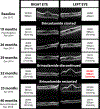Efficacy of topical brinzolamide in children with retinal dystrophies
- PMID: 31496370
- PMCID: PMC7009217
- DOI: 10.1080/13816810.2019.1660381
Efficacy of topical brinzolamide in children with retinal dystrophies
Abstract
Background: Inherited retinal dystrophies are a leading cause of irreversible blindness in children in the United States. Topical carbonic anhydrase inhibitors have improved central vision and cystoid macular edema in patients with retinal dystrophies, but few studies have assessed their efficacy in children. Materials and Methods: A retrospective chart review was performed with Institutional Review Board approval to identify pediatric patients with inherited retinal dystrophies who received topical brinzolamide at a single university center between 2008 and 2015. Serial visual acuity and central macular thicknesses were compared to assess the efficacy of brinzolamide. Results: Seven subjects were identified who met the inclusion criteria. Four had juvenile X-linked retinoschisis, two had retinitis pigmentosa, and one had Leber congenital amaurosis. All were prescribed brinzolamide thrice daily; however, one patient was completely non-compliant. Four of the six treated patients exhibited a mild decrease in central macular thickness in both eyes during the study with all six treated patients having significantly improved vision at the first endpoint, 33.2 ± 8.2 months after treatment initiation. For treated patients, average visual acuity (LogMAR) ± standard error of the mean improved from 0.5 ± 0.04 pre-treatment to 0.3 ± 0.1 at the second endpoint, 50.2 ± 7.3 months after treatment initiation. Conclusions: Mild anatomic improvement of macular cysts was seen in pediatric patients using brinzolamide. Visual acuity improvement occurred even without significant reduction in macular cysts. Further studies are needed to determine whether the beneficial effects of carbonic anhydrase inhibitors are sustained in children with inherited retinal degenerations.
Keywords: Brinzolamide/carbonic anhydrase inhibitors; Leber congenital amaurosis (LCA); Retinitis pigmentosa (RP); X-linked juvenile retinoschisis (XLRS); inherited retinal dystrophy.
Figures




References
-
- Iida T, Yannuzzi LA, Spaide RF, Borodoker N, Carvalho CA, Negrao S. Cystoid macular degeneration in chronic central serous chorioretinopathy. Retina. 2003;23(1):1–7; quiz 137–8. - PubMed
-
- KINSEY VE, REDDY DV Turnover of total carbon dioxide in the aqueous humors and the effect thereon of acetazolamide. AMA Arch Ophthalmol. 1959;62(1):78–83. - PubMed
-
- Fishman GA, Gilbert LD, Fiscella RG, Kimura AE, Jampol LM. Acetazolamide for treatment of chronic macular edema in retinitis pigmentosa. Arch Ophthalmol. 1989;107(10):1445–52. - PubMed
-
- Lusthaus J, Goldberg I. Current management of glaucoma. Med J Aust. 2019;210(4):180–7. - PubMed
Publication types
MeSH terms
Substances
Grants and funding
LinkOut - more resources
Full Text Sources
Other Literature Sources
Research Materials
Miscellaneous
